- Doctors recommend bitewing X-rays once a year to detect cavities and decay between the teeth. You may need a periapical radiograph to diagnose fractures, cracks, and abscesses.
- An FMX includes 16 to 18 images to view the entire dentition and incoming teeth. Occlusal X-rays help identify the need for caries treatment.
- Most dental insurance plans cover the cost of X-rays.
Need a dental x-ray this week? Use Authority Dental to find emergency dental clinic near you.
What dental X-ray do you need for your problem? Here's everything you need to know.
Intraoral X-rays
Intraoral means inside the mouth. That’s exactly where the film goes when these X-rays are taken. Intraoral radiographs are the most common dental exam and provide the most detail.
Bitewing X-ray
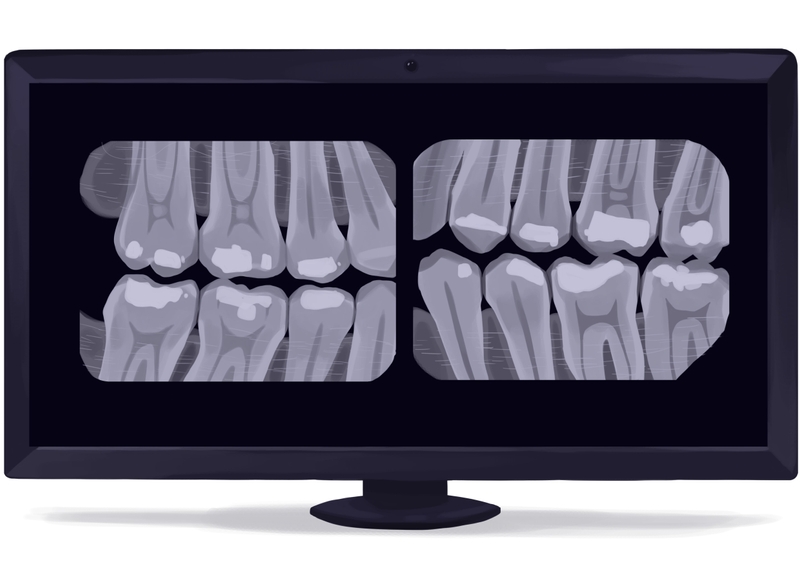
Picture by Authority Dental under CC 2.0 license
A bitewing is performed once a year, unless necessary before particular treatment. It is sometimes referred to as a “check-up X-ray”. That’s because it’s really quick and easy but also because it gives the dental professional a lot of information, especially about tooth decay and decay between teeth.
Tooth decay happening on the inside of your tooth or between dentition can be easily diagnosed. Changes in bone thickness, signs of gum disease, and decay between the teeth will also show up on the image.
Bone loss can be caused by tooth loss or tooth decay as well as chronic periodontitis, which is a preventable issue as a result of poor oral hygiene. Bone loss can affect anyone, regardless of age. However, if you want healthy teeth, you can prevent it not only with good oral hygiene, but with regular check-ups to your dentist, which most dental insurance plans cover.
With the help of certain dental imaging technology, dentists can spot bone loss in the early stages. And while insurance coverage of such exams may vary from one company to another it's often convenient to have your teeth and mouth conditions examined by a professional dentist.
A bitewing captures a small section of the lower and upper teeth. If you aren’t focusing on a problem area, multiple can be taken for a general overview. Additional radiographs are usually less expensive than the first one. In some cases they may be taken at no additional charge.
The name stems from the shape of the device you put into your mouth. You bite down on a wing-shaped piece of film. The dentist or hygienist leaves the room for each snapshot and you might wear a protective bib.
Related procedures include dental exams, professional teeth cleaning, cavity filling, and cosmetic treatments.
Periapical X-ray
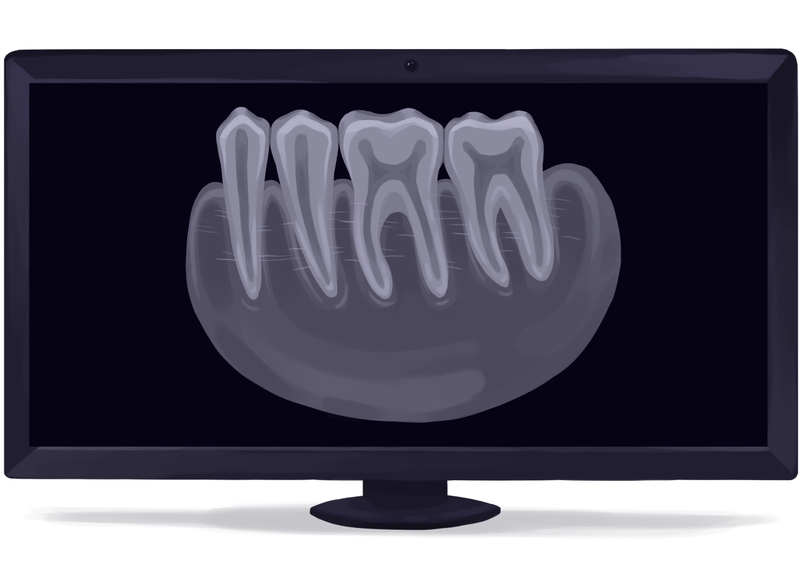
Picture by Authority Dental under CC 2.0 license
A periapical X-ray shows a small section of the mouth, it concentrates on one or two teeth. The entire tooth from the crown to the tip of the root (below the gums) will be visible. It is usually performed 1-2 times a year.
It may help diagnose issues you didn’t know you had such as impacted teeth, fractures, cracks, and abscesses. Most often it is taken when the patient experiences acute pain. This could be undiagnosed pain or pain that is suspected to be caused by failure of prior treatment.
The dental professional will leave the room. You might have to wear a protective bib, one covering your thyroid gland at least. The film will usually be mounted on a metal rod with a ring. You will have to bite down on the device. This will help it stay still.
You will probably need more than one picture. Additional radiographs are usually less expensive than the first.
Periapical X-rays are taken when you come in for teeth whitening, SRP, RCT, veneers, crown placement, and tooth extraction.
FMX
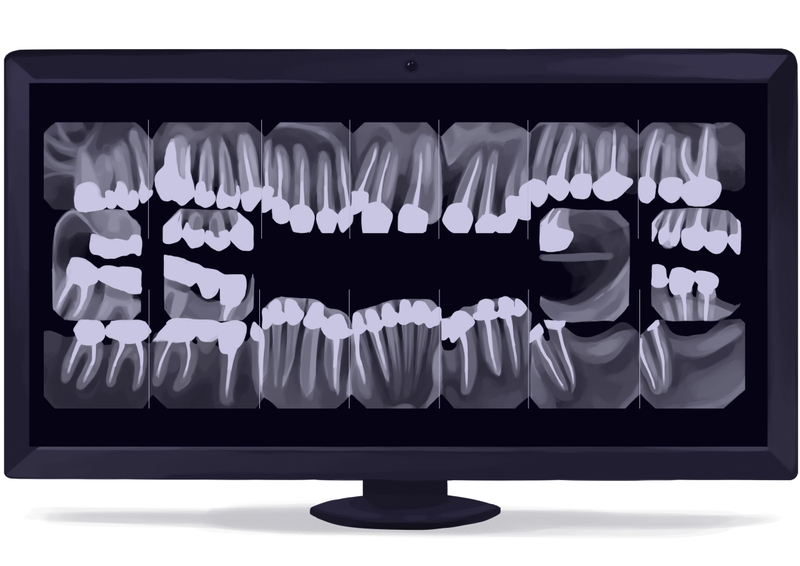
Picture by Authority Dental under CC 2.0 license
Sometimes the dental hygienist or dentist will decide that rather than taking individual periapical or bitewing X-rays, an FMX is needed.
FMX means a full-mouth series of X-rays. It includes a set of 16-18 images to observe the full set of teeth, incoming teeth, and the surrounding tissue. These usually include 4 bitewings and 12-14 periapicals.

The radiographs will show the structure of your entire mouth as well as details of individual teeth. The jaw will be presented from both sides. This will give the dental professional a good idea of the general structure of your mouth.
They can detect abnormalities in the structure of the mouth, decay, gum disease, and abscesses.
The procedures will not differ from what has been described above. Some offices require you to have an FMX if you are a new patient. For established patients, 4 bitewings and 2 periapicals (of the front teeth) are usually taken every 6-12 months.
Occlusal X-ray

Picture by Authority Dental under CC 2.0 license
This type of X-ray concentrates on tooth development. Each radiograph shows an entire arch, upper or lower. An occlusal X-ray is most commonly used to help detect the need for a cavity filling or before orthodontic work.
It is mainly done in children who are experiencing problems related to unusual tooth alignment. It also captures unerupted teeth, or teeth that are erupting in unexpected places. The image shows the roof or floor of the mouth.
Caries below the gumline, fractures in the jawbone, abscesses, and lodged foreign objects can be easily spotted.
Extraoral X-rays
For the following three types of X-rays, the film remains outside the mouth. These show the teeth as well as the surrounding structures such as the jaw and skull.
Panoramic X-ray
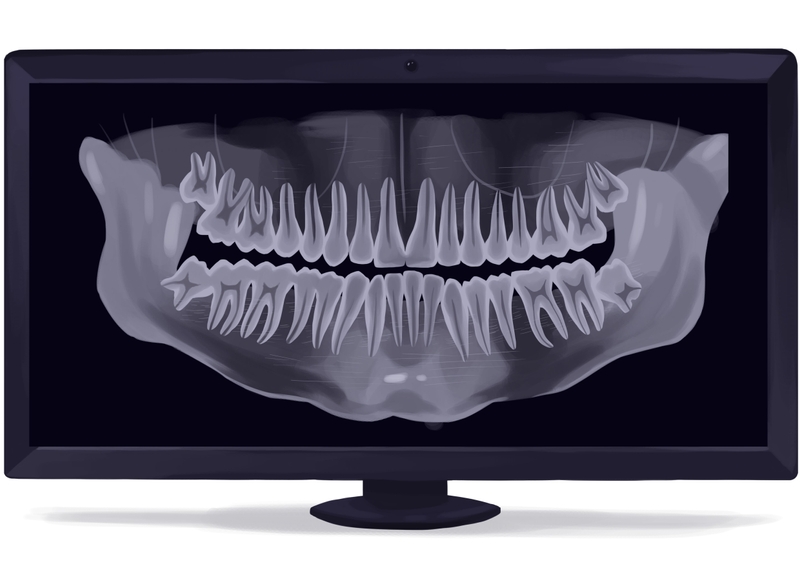
Picture by Authority Dental under CC 2.0 license
A panoramic X-ray is a very common procedure at the dental office. It provides a big-picture view that shows the relationship between the jaws and teeth, as well as the airways such as the nasal cavities and sinuses. This is a non-invasive test that is the way to go if you are unsure which tooth is hurting.
It requires a little preparation. You will have to remove your jewelry, glasses, and other metal objects. You will be given a lead apron to protect the rest of your body from radiation exposure.
You might have to stay standing for this X-ray. Your head and chin will be placed in a device that will help you remain motionless. This is vital, as any movement could distort the radiograph.
Even though the device will rotate around you, all teeth will be shown on a flat image. Both arches along with surrounding structures and tissues will be visible.

You will probably have it if you decide on a procedure that requires a comprehensive dental overview, such as implant placement. Many orthodontists also like to do a panoramic mouth X-ray before performing any orthodontic work.
Other than before major procedures it can be done every 3-5 years.
Cephalometric projections
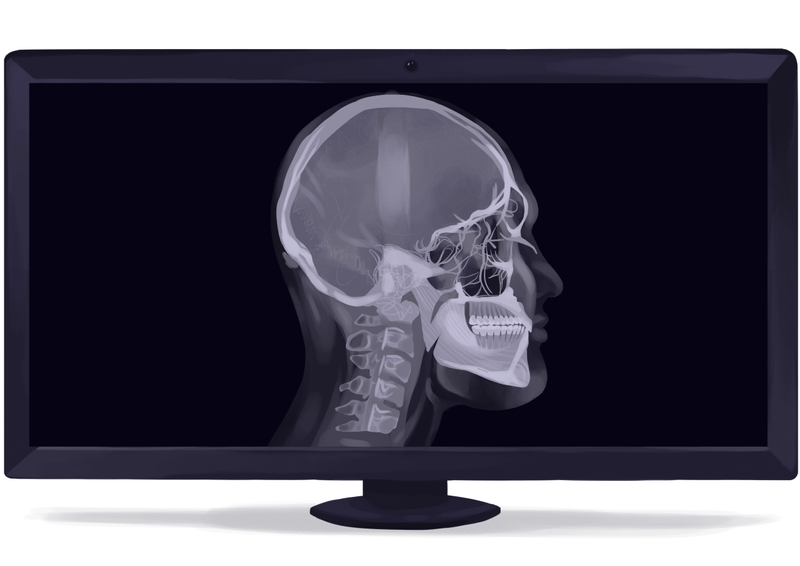
Picture by Authority Dental under CC 2.0 license
A “ceph”, as it is sometimes referred to, is usually taken before and after orthodontic treatment. This includes not only traditional braces but also clear aligners such as Invisalign.
This X-ray concentrates on the patient’s profile and helps predict the outcome of tooth movement. Exposure takes approximately ten seconds, and the image is developed in about five to six minutes. It will be two-dimensional.
The dental professional will use tracing paper to “trace the ceph”. The movement of the dentition and its growth patterns can be calculated.
Cone-beam computed tomography (CBCT)
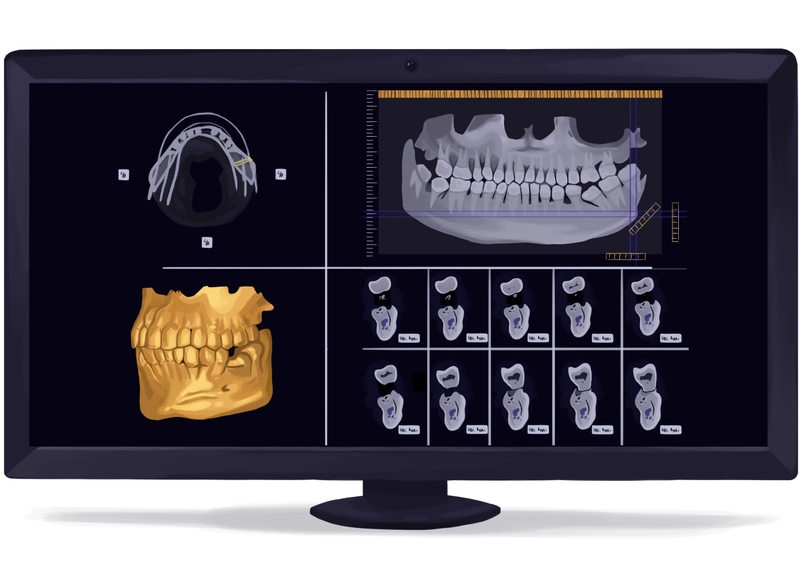
Picture by Authority Dental under CC 2.0 license
A cone-beam CT is often confused with a medical CT scan, though it produces a lot less radiation. It provides considerably more details than other types of dental X-ray, as the image produced is 3D.
It is used when other types turn out to be insufficient, before oral surgery, or invasive RCT. During the procedure, a beam in the shape of a cone will move slowly around your head. You will have to remain motionless for the shot to be clear.
Three radiographs are captured in a single scan. Those pictures, or “views”, are then combined to produce a three-dimensional image. The dentist will be able to assess space and internal structures in the mouth. The teeth, soft tissues, nerve pathways, and bone structure will all be visible.
The dentist will also be able to see which direction the roots grow in. This makes oral surgery less invasive; it is easy to see where the incisions have to be made.
Cone beam X-rays are the most detailed, accurate, and diagnostic form of radiograph. This type is particularly helpful with implant placement, wisdom tooth extraction and root canal treatment. Some complications, such as permanent nerve damage, can be more easily avoided if this X-ray is done.
Digital dental radiographs
Advances in dentistry technology and medical science have had a significant impact on regular dental x-rays, dental procedures, and overall oral health.
Digital X-rays expose the patient to significantly less radiation than traditional X-ray film radiographs. Safety is the most important reason for using this type of dental imaging. Since the level of radiation is lower, this allows for more frequent routine dental X-rays to prevent any oral disease and promote overall dental health.
Digital radiography is a new technology that might one day replace traditional X-ray film. It’s not a type of radiograph but a different means of taking one. You can, for example, take a bitewing this way.
The advantages include the fact that images are processed immediately, so they can be viewed straight away. These images are editable; the technician can adjust contrast and deduce more information from the radiograph. There is no real difference in terms of price for the patient.
The biggest disadvantage is that some of the sensors are bigger and bulkier than traditional ones. This means it is less comfortable for the patient and that it can’t easily be disinfected. The device is covered in disposable plastic which is necessary for infection control.
Digital X-rays expose the patient to significantly less radiation than traditional X-ray film radiographs. Besides, this type of radiography is commonly used to detect tumors. There are many types of tumors, including dental tumors which often develop under the soft tissue of the jaw. These tumors can be benign or malignant, and can be spotted with these radiographs.
Cost of dental X-rays explained
Dental X-rays costs near you vary from $25 to $750. The type of dental X-ray you need, and, of course, how many, are what impacts the price most. A dental professional is the one who can accurately diagnose what kind is appropriate in your case.
The cost of intraoral and extraoral X-rays can be very different.
| INTRAORAL X-RAYS TYPE | AVERAGE COST | COST RANCE |
|---|---|---|
| Bitewing | $35 | $25-$50 |
| Periapical | $35 | $25-$50 |
| FMX | $150 | $100-$300 |
| Occlusal | $50 | $25-$100 |
And prices for extraoral X-rays:
| EXTRAORAL X-RAYS TYPE | AVERAGE COST | COST RANCE |
|---|---|---|
| Panoramic | $130 | $100-$250 |
| Ceph | $150 | $70-$300 |
| Cone-beam CT | $350 | $150-$750 |
Extraoral X-rays are usually a bit more expensive. This is because they require equipment that costs a lot more. Moreover, small offices may not have the necessary tools, and you could be sent somewhere else.
If that is the case, you should be prepared for a higher fee. Dental offices do this to avoid an influx of patients who are just going to do small procedures instead of full treatment.
Are dental X-rays safe?
Generally, there is a lot of misconception around radiography. The radiation produced during an X-ray is very small, comparable to the amount you would experience during a sunny day. The exposure from four bitewings is comparable to a two-hour airplane ride.
What’s more, the benefits of early detection of any issues outweigh the risk of a minimal amount of radiation. There is also no reason to be worried about children getting X-rays. Radiography can be safely used in pediatric care.
The biggest contraindication to X-rays is pregnancy. Still, accommodation can be arranged if necessary. For example, if a woman becomes pregnant during long-term treatment, she and the baby will be protected by a heavy-duty leaded apron and a thyroid collar.
FAQ
How often do you need dental X-rays?
You should get a bitewing twice a year. It is convenient to do this during your bi-annual check-ups. An intraoral periapical should be done when you’re a new patient to an office.
Other than that, X-rays are not routine procedures. They are rather done when something unexpected happens or if you are considering some kind of invasive treatment. Radiographs can also be great in diagnosing dental problems.
How much radiation is there in dental X-rays?
Can you get a dental X-ray during pregnancy?
Are dental X-rays painful?
How to read a dental X-ray?
Does insurance cover dental X-rays?
Routine bitewings or even FMX will likely be covered, as they are considered preventive care. There’s a chance that you will be reimbursed with no deductible. Thanks to their diagnostic nature, X-rays can also be paid by insurance when taken to aid therapeutic or cosmetic treatment.
Additionally, you can consider signing up for a dental plan. They have no yearly maximums, waiting periods, and absolutely no paperwork. In fact, they won’t need an X-ray to give you a discount on any procedure. Reductions reach 60%.
Jason Chong, DDS
Bitewings are recommended every other cleaning visit, or every twelve months to evaluate for caries and to identify subgingival calculus.